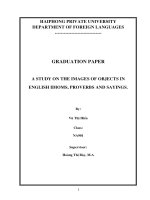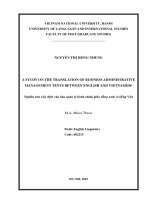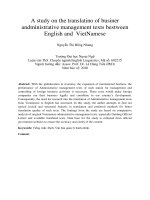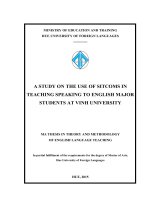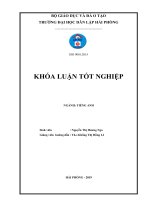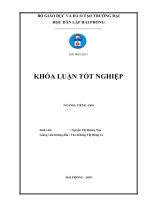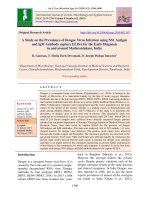A STUDY ON THE USAGE OF HYPERBOLE IN DAILY COMMUNICATION BETWEEN ENGLISH AND VIETNAMESE
Bạn đang xem bản rút gọn của tài liệu. Xem và tải ngay bản đầy đủ của tài liệu tại đây (310.66 KB, 51 trang )
TÂY NGUYÊN UNIVERSITY
FACULTY OF FOREIGN LANGUAGES STUDIES
-------------------
GRADUATION THESIS
TITLE: A STUDY ON THE USAGE OF HYPERBOLE
IN DAILY COMMUNICATION BETWEEN ENGLISH
AND VIETNAMESE
Student: Lê Ngọc Nguyên Chính
Student code: 12701004
Class: Pedagogy of English K12
Supervisor: Hoàng Thị Xuân M.A
Đắk Lắk, June 2016
1
ACKNOWLEDGEMENTS
Above all, I would like to express my deepest thanks to my supervisor Mrs.
Hoang Thi Xuan – M.A, who has given me a lot of suggestions on the topics of my
thesis and who has given me many ideas and corrections on my outline as well as
my thesis during the time I was conducting it.
I am also grateful to the Teachers of Faculty of Foreign Languages Studies at
Tay Nguyen University, who have given me useful lessons and experience for the
four years I have been in the university. They are the ones who gave me the basic
background as well as knowledge of the specific fields so that I am able to carry out
the research.
I also want to send my best gratitude to my family and my friends who have
supported me and given me help whenever I need so that I can complete my
research.
Buon Ma Thuot, June 6th 2015
Student
Lê Ngọc Nguyên Chính
2
TABLE OF CONTENTS
ACKNOWLEDGEMENTS............................................................................................................. 2
ABSTRACT..................................................................................................................................... 5
CHAPTER 1: INTRODUCTION.................................................................................................. 6
1.1 Statement of the problem................................................................................................. 6
1.2 Objectives ............................................................................................................................. 7
1.3 Significance of the study .................................................................................................. 8
1.4 Outline of the study ........................................................................................................... 8
CHAPTER 2: LITERATURE REVIEW....................................................................................... 9
2.1 Primary meanings and secondary meanings.............................................................9
2.2 Figures of speech................................................................................................................. 9
2.3 Hyperbole............................................................................................................................ 11
2.3.1 Hyperbole in English ................................................................................................... 12
2.3.1.1 Definition .................................................................................................................... 12
2.3.1.2 Functions of hyperbole ........................................................................................... 12
2.3.1.2.1 Hyperbole is used to insult.................................................................................13
2.3.1.2.2 Hyperbole is used to boast.................................................................................. 13
2.3.1.2.3 Hyperbole is used as a rhetorical device .......................................................14
2.3.1.3 The syntax aspect of hyperbole ...........................................................................16
2.3.2 Hyperbole in Vietnamese .......................................................................................... 17
2.3.2.1 Definition..................................................................................................................... 17
2.3.2.2 Functions of hyperbole............................................................................................ 17
2.3.2.2.1 Hyperbole is used to insult.................................................................................19
2.3.2.2.2 Hyperbole is used to boast.................................................................................. 19
2.3.2.2.3 Hyperbole is used as a rhetorical device .......................................................20
2.3.2.3 The syntax aspect of hyperbole............................................................................21
CHAPTER 3: METHODOLOGY............................................................................................... 24
3
3.1 Subjects of the study........................................................................................................ 24
3.2 Scope of the study............................................................................................................. 24
3.3 Research questions.......................................................................................................... 24
3.4. Research methods........................................................................................................... 24
CHAPTER 4: FINDINGS AND DISCUSSIONS.......................................................................26
4.1 Some hyperbolic words and phrases in English and Vietnamese daily
conversations............................................................................................................................ 26
4.2 Similarities between English and Vietnamese hyperbole in daily
conversations............................................................................................................................ 26
4.2.1 In terms of concept ...................................................................................................... 26
4.2.2 In terms of functions.................................................................................................... 26
4.2.3 In terms of the syntax aspect..................................................................................... 27
4.2.3.1 Using adjectives to express hyperbole...............................................................27
4.2.3.2 Using figures to express hyperbole ....................................................................28
4.2.3.3 Using comparative structures to express hyperbole.....................................29
4.2.4 In terms of the usage.................................................................................................... 31
4.3 Differences between English and Vietnamese hyperbole in daily
conversations............................................................................................................................ 32
4.3.1 In terms of concept ...................................................................................................... 32
4.3.2 In terms of functions.................................................................................................... 32
4.3.3 In terms of the syntax aspect..................................................................................... 33
4.3.4 In terms of usage........................................................................................................... 33
4.4 Summary............................................................................................................................. 34
CHAPTER 5: CONCLUSIONS AND RECOMMENDATIONS...............................................35
5.1 Conclusions......................................................................................................................... 35
5.2 Recommendations............................................................................................................ 36
REFERENCES.............................................................................................................................. 38
APPENDIX................................................................................................................................... 40
4
ABSTRACT
Hyperbole is a commonly used figure of speech in both English and Vietnamese.
Currently, studies on hyperbole in these both languages are just limited to the scale
of that own language (merely focus on only Vietnamese or only on English). There
are plenty of researches available concerntrating on the literature of two languages.
However, an investigation on how hyperbole is used in practical interaction
5
between English and Vietnamese (specifically in daily communication) hasn’t been
done yet. For that reason, this study is carried out to solve that problematic issue in
order to give readers a general constrastive analysis on hyperbole in two languages.
The definition, functions and the syntax aspect of hyperbole in each language will
be presented in this study. These aspects are the fundamental theories for
constrastive analyzing on the similarities and the differences of hyperbole in
between English and Vietnamese. In the latter parts of the study, some results and
recommendation will be concluded. The results are the outcome of constrastive
analysis from basic knowledge as stated above. Some implications will be given in
the recommendation chapter and they will mainly focus on how hyperbole is used
in communication and education. It is hoped that this thesis would give readers an
easy-to-understand brief view on hyperbole in English and Vietnamese. Lastly, I
hope it will offer useful knowledge for your understandings in further researches
regarding hyperbole (if there is any), especially bilingual speakers of two languages
(English and Vietnamese)
CHAPTER 1: INTRODUCTION
This chapter gives the statement of the problem, the objectives, the
significance, and the outline of the study.
1.1 Statement of the problem
English is spoken widely in many parts of the world nowadays, and without doubt it
6
plays a significant part in international communication. In any language, it is
noticeable that the language itself does not exist with only the lexical items – a
single word, a part of word, a chain of words and some fundamental grammatical
rules. Language phenomenon appears throughout the development of language, for
this reason the study of semantics, morphology, syntax, phonology and other
departments of linguistics are carried out. When a speaker of any language utters, it
is necessary to understand the meaning. To that end, semantics, a branch of
linguistics that studies the meaning of language has been founded.
There are three main aspects in semantics: lexical meaning, sentence meaning and
utterance meaning [Lyons, 1995: 33]. The study of lexical meaning (or as known as
word meaning) in semantics points out the meaning of words when they are
standing on their own. This may concern many aspects: semantic features, lexical
gaps, figures of speech, etc... Many people may concern and query what figures of
speech are. Figures of speech relate to the ways of speaking in languages. For a
native speaker of a language, it is crucial to master the language by using different
ways of speaking. A figure of speech is a word or a phrase of which the meaning is
not literally conveyed for unusual purposes [To Minh Thanh, 2007:36]. Simile,
metaphor, metonymy, personification, litotes, irony, hyperboles are some common
figures of speech that can be found in semantics. Particularly, hyperbole is the
figure speech that is mostly used in daily communication in any languages.
Hyperbole is the act of delivering an exaggeration to emphasize some certain
meanings by the speaker. In both English and Vietnamese, two languages with
different characteristics, hyperbole is found in many daily conversations. In terms
of cultural diversity in English speaking countries and Vietnam, the ways of giving
exaggeration may or may not differ in context. As a speaker of both languages, it
urges me to seek for answers of the usage of hyperbole in both languages,
specifically here is in daily communication. For that reason, the study with the title
“A Study on the Usage of Hyperbole in Daily Communication between English
and Vietnamese” is conducted.
1.2 Objectives
The study aims:
7
-
To list some words, phrases or structures related to hyperbole that are used in
-
daily conversations in both language English and Vietnamese
To point out the similarities and differences in the usage of hyperbole used in
English and Vietnamese in daily conversations in terms of cultural diversity,
-
semantics and syntax.
To propose some implications in mastering the use of hyperbole in English
for Vietnamese speakers when engaging in a conversation.
1.3 Significance of the study
The outcome of the study points out the usage of hyperbole in two different
languages: English and Vietnamese; as well as the similarities and dissimilarities.
This study may help bilingual speakers (English and Vietnamese) master the way
hyperbole is used in their expression. Moreover, it also gives people a perspective
of hyperbole in terms of cultural and linguistic aspects.
1.4 Outline of the study
Chapter 1: INTRODUCTION
This chapter provides the statement of the problem, the objectives, the
significance and the outline of the study.
Chapter 2: LITERATURE REVIEW
This chapter gives theoretical background brief of semantics, its subdivision
and hyperbole in particular
Chapter 3: METHODOLOGY
This chapter presents the subject of the study, the scope, the content and the
research method of the study.
Chapter 4: FINDINGS AND DISCUSSION
This chapter presents the usage of hyperbole used in English and
Vietnamese: similarities and dissimilarities.
Chapter 5: CONCLUSIONS AND RECOMMENDATIONS
This chapter gives conclusions of the study and suggests recommendations.
8
CHAPTER 2: LITERATURE REVIEW
This chapter gives theoretical background brief of semantics and its
subdivision. An overview of hyperbole is given in the chapter to illustrate some
problematic issues that lead to the reason for the study.
2.1 Primary meanings and secondary meanings
It’s common sense that understanding meaning of a word is concerned in a
language. According to To Minh Thanh [2007:34], lexical items (or words) in a
language may have primary and secondary meanings.
The primary meaning (also known as literal meaning) of a word is the first common
meaning that it delivers to people of a language when it stands alone.
The secondary meaning (also known as figurative meaning) of a word is the extra
meaning in addiction to the primary meaning. Moreover, the secondary meaning is
contextually depended. The figurative meaning is used in order to create a special
linguistic effect to the readers or speakers.
For instance, the noun “wing” has some literal meanings in certain contexts:
-
Part that projects from the side of a jet: the two wings of an airplane;
A group of political party or other organization: the political wing of the
IRA.
How ever the noun “wing” may also have some figurative meaning in these
contexts:
-
We hope college life will help him to spread his wings a bit.
“spread his wings” here mean “to help him do what he likes”
-
Having a new child to take care of has clipped her wings a bit.
“clipped her wings” here mean “stopped her from doing what she likes”
[Examples from To Minh Thanh, 2007:35 and Oxford Dictionary of English]
2.2 Figures of speech
A figure of speech is “a word or phrase which is used for special effect, and which
does not have its usual or literal meaning.” [Richards et al, 1987: 105]
As stated, many lexical items have figurative meaning which denote unusual
meanings. A figure of speech absolutely is figurative and used when there is the
need for delivering indirect message toward other speakers or readers. Some
9
common figures of speech are: simile, metaphor, personification, metonymy, litotes,
euphemism, hyperbole, etc...
Simile is the way one thing is in compared to another thing. For example: as brave
as lion, a face like a mask, etc… Simile is used to compare things directly or plainly
by using the a function word like “as” or “like”:
-
My hands are as cold as ice (My hands are really cold)
Tom eats like a horse (Tom eats like a horse)
[Examples from To Minh Thanh , 2007:36]
Metaphor is the way something is conveyed differently from the literal meaning by
using a word.
-
She has a heart of stone (She is a heartless and insensitive person)
[Example from To Minh Thanh, 2007:37]
heart is an organic part of human body made of biological cells whereas stone is
made of solid rock so a heart can never be made of stone. By using “stone” to
describe the characteristic of the heart, readers can have an abstract conception of
the man in the sentence.
Personification is a special effect to humanize unconscious objects or living
animals:
-
The ocean danced in the moonlight.
it’s quite illogical to find that “the ocean” can “dance” in this example. “Ocean” is a
natural phenomenon and does not have any body parts such as eyes, mouths, etc…
like human beings in order to dance. In this case the ocean was personified.
[Example from />Metonymy is the replacement of the name of one thing by that of another thing to
which it related:
-
He succeeded to the crown (“the crown” is equal to “the royal office”)
[Example from To Minh Thanh, 2007:39]
Litotes is the use of tenderer or gentler statement to state something:
-
I am afraid that no passenger is allowed to smoke in here. (Nobody can
smoke here)
Commonly, an expression of litotes is an “ironical understatement, especially using
a negative to emphasize the contrary.” [Crowther (ed.), 1992: 527]
-
It’s not bad. (= It is fine.)
It wasn’t easy. (= It was very difficult.)
10
[Examples from To Minh Thanh, 2007:45]
Euphemism is the way words are used to avoid indecency, impoliteness or
offensiveness when expressing something:
-
He passed a way = He died
-
Restroom = WC
Hyperbole is a “exaggerated statement that is made for special effect and is not
meant to be taken literally.” [Crowther (ed.), 1992: 446]
-
I haven’t seen you for ages = I haven’t seen you for a long time
[Example from Claridge, 2011:15]
Hyperbole has the opposite functions with understatement (also known as Litotes)
in English. Hyperbole intensifies the meaning of a statement whereas
understatement weakens a saying. They both share ironical effects in certain
circumstances.
[ />For instance:
-
It wasn’t easy (ironical understatement that means “It was so difficult”)
I owe you a thousand thanks (ironical exaggeration that mean “I owe you a
lot”)
[Example from To Minh Thanh, 2007:45]
In certain circumstances in daily communication, hyperbole may exist in the form
of “simile” as there are many comparative structures using conjunction (like “as” or
“như”). For instance: “as clear as crystal”, “as gentle as a lamb”, “as light as a
feather”, “im như thóc”, “hiền như bụt”, etc… [Table 1 – Appendix].
2.3 Hyperbole
On the previous section, we have a basic glance through hyperbole. This part will
present specifically the details of hyperbole in certain languages; particularly here is
hyperbole in English and Vietnamese. In daily conversations, sometimes there’s a
need for linguistic effects to make the information exchanges more efficient in
terms of convincing and humoring people or showing one’s own attitudes. Figures
of speech such as simile, litotes, personification, hyperbole, metaphor, euphemism,
etc…as stated above are forms of linguistic effects in languages and they’re exactly
the devices we need to bring these effects to daily conversations. Particularly,
hyperbole seems to be one of the devices that have a high rate of usage frequency.
11
According to Claridge, there is one English hyperbole expression every 4 minutes
in Scotland. Vietnamese people also use hyperbole repeatedly in daily routine. In
addition, this can also be widely found in many TV reality shows in Vietnam like
“Hoi xoay dap xoay” or comedy programs such as “On gioi cau day roi”, “Chet
cuoi”, etc.… by VTV3. Hyperbole has many functions that boost the attraction of
conversations in languages and clearly favored by speakers around the world
especially for presenters, politicians, comedians, etc… Furthermore, it’s necessary
to acknowledge the usage of hyperbole for implication in teaching students in order
to avoid unpleasant situations as hyperbole can be used for the purpose of
“insulting” in conversations.
2.3.1 Hyperbole in English
2.3.1.1 Definition
According to Wikipedia: “Hyperbole is the use of exaggeration as a rhetorical
device or figure of speech. In rhetoric, it is also sometimes known as auxesis (lit.
"growth"). In poetry and oratory, it emphasizes, evokes strong feelings, and creates
strong impressions. As a figure of speech, it is usually not meant to be taken
literally”.
The New Oxford American Dictionary defines that hyperbole is “exaggerated
statements or claims not meant to be taken literally.”
Here are a few examples of English hyperbole:
-
I’ve invited millions of (= a lot of) people to my party.
She sheds floods of tears (= cries a lot) whenever she is upset.
[Examples from To Minh Thanh, 2007:45]
In the examples above, hyperbole words are used to express something that is
beyond the reality: it’s rare for a person to hold a party with millions of guests and
nobody can cry like loads of floods.
2.3.1.2 Functions of hyperbole
In English, hyperbole is commonly used to amplify a point made by speakers in a
humorous way or to show satire (irony, sarcasm) in writings or speeches. When
using hyperbole there’s a lie inside the hyperbolic word but the meaning of the
whole hyperbolical sentence is still based on certain truth. Let’s consider this
conversation:
12
Norrine:
That’s Edward Fox on the radio
Chris:
Aaargh. Brushing past the plant and it fell over, that’s all.
Susan:
This place is turning into a jungle.
[Claridge, 2011:8]
in this conversation “jungle” is a lie because it’s common knowledge that a “jungle”
is an area of land with forests and living wildlife. However, in this circumstance,
the speakers are in a radio studio so the whole meaning of the sentence “this place is
turning into a jungle” is overstated because a studio cannot turn into a jungle as it
doesn’t’ have forests and animals.
2.3.1.2.1 Hyperbole is used to insult
In conversations, there’s always a need to show anger or displeased attitudes of
speakers. In such cases, hyperbole is used to deliver the messages between speakers.
Here are a few examples in English (bold words are exaggerated words):
• your mother is so old she got spider webs under her arms
• so old, she took her driving test on a dinosaur
• so skinny she could split through a needle’s eye
• so small, you play hide-and-go-seek, y’all c’slip under a penny
[Claridge, 2011:159]
Considering the first example, we normally see “spider webs” on the ceiling of a
house. Nevertheless, in this case, a mother got “spider webs” under her arms and
this statement is completely unrealistic and exaggerated because a spider cannot live
or produce any webs on human bodies. “Spider webs” usually attracts people to the
thought of a place, which is dirty. By using this expression, the speaker obviously
carried out an insulting attitude toward the opposite speaker. In the next example,
the adjective “old” is attached with the image of a woman “taking her driving test
on a dinosaur” seem unusual because naturally dinosaur had been extinct millions
of year ago. Additionally, everyone drives kinds of vehicle like a car, a truck, etc…
No one would drive an animal, only ride. By uttering in this way, the speaker
clearly expresses an annoyed attitude toward the woman.
2.3.1.2.2 Hyperbole is used to boast
Speakers of a language in conversations sometimes make boast of their words to
express their pride or show the narcissistic personality. These are some illustrations
13
found in a English conversation:
S1: I am the poisonous mushroom that makes the fearless vomit.
S2: As for me, I am the ravenous cock, the poison does not matter to me.
S1: Behave yourself, little boy, or you will burn your foot, for I am the redhot cinder.
S2: But me, I am the rain that extinguishes the cinder; I am the boisterous
torrent that will carry you off.
S1: I am the mighty silk-cotton tree that looks from on high on the tops of
other trees.
S2: And I, I am the strangling creeper that climbs to the top of the forest
giant.
[Claridge, 2011: 160]
S1 and S2 in this conversation show off their abilities, which are out of this world.
In the first sentence of the conversation, S1 says that S1 is a “poisonous mushroom”
that makes the “fearless vomit”. This makes no sense at all because a person cannot
be a mushroom and in fact no mushroom in this world can make “fearless” (an
abstract concept) vomit. Following this, S2 is up against S1 by considering himself
a “ravenous cock” (a hungry chicken) that is not afraid of that mushroom. Next in
the conversation, S1 boasts to be a “red-hot cinder” (a burned coal or wood) that
can hurt S2. Then S2 declares himself to be “the rain that extinguishes the cinder”
which is unrealistic because “rain” is a phenomenon in nature. Rain is water in the
shape of drops falling down from the sky; no human being could turn into this
natural form. In addition, S2 also claims him as a “boisterous torrent” (a ruthless
river stream) to stop S1 from being a “cinder”. When S1 loses over S2 statements,
her carries out a new image: “the mighty silk cotton tree” that is higher than any
other trees implying S2 is beneath. Finally, S2 finishes the conversation by stating
that he is “the strangling creeper that climbs to the top of the forest giant” implying
that he’s above S1 (creeper is a type of plant that grows anywhere it could and
usually rise up other trees). For carrying out such overstatements, S1 and S2
completely boast against each other.
2.3.1.2.3 Hyperbole is used as a rhetorical device
Rhetoric is the art of persuasive in spoken or written language. In general, there’s
14
always a need for rhetoric so that speakers can succeed in reaching their goals when
their speeches or writings are carried out, particular for presenters, politicians, poets
or educators, etc.…
-
In persuasion:
For English speakers like politicians and government officers like presidents,
senators, and speaker of the House, etc.… there is always a need for rhetoric in
order to convince people better and hyperbole is found to be used commonly. Here
are some English speeches that contained exaggerated statements:
• I think I see the incurable Difficulties of the Landed Men, fettered under
the Golden Chain of Equivalents, their pretty Daughters petitioning for
want of Husbands, and their Sons for want of Employments.
• I think I see our Mariners delivering up their Ships to their Dutch
Partners; and what through Presses and Necessity, earning their Bread
as Underlings in the Royal English Navy.
[Claridge, 2011:221]
Politicians who gave these speeches in these cases obviously could not see all the
things in their speeches happen in real life because they have to run the countries
meanwhile the citizens and the soldiers were far away from the politicians doing
their jobs. For that reason, politicians were not really there to witness all of those
people so what the politicians said is just an exaggeration. The way they gave these
speeches is just to earn the endorsements from people and make the speeches more
inspirational.
-
In humor
For most presenters running a seminar, perhaps humor is also a needed factor to
help making the presentation effective, less boring and entertaining as well. Like
presenters, politicians and other people also have the need for humors in not only
speeches but also routine conversations. Hyperbole is one of the forms that could
deliver humor into speeches and conversations. This is an illustration in English:
“But of all the things I remember, I don't have a clue who the commencement
speaker was that evening, and I certainly don't remember anything they said. So,
acknowledging that fact, if I can't make this commencement speech memorable, I
will at least try to make it short.”
[University of Texas at Austin 2014 Commencement Address - Admiral William H.
15
McRaven]
In his mind, of course the admiral knew that he would deliver a memorable speech;
he just exaggerated to make all the students laughed at the commencement address.
It’s common knowledge that many commencement speeches in ceremonies like
graduation, wedding, etc.… are rather long than short. By making such
exaggeration like this, his speech was more fascinating and entertaining.
2.3.1.3 The syntax aspect of hyperbole
In English, there are several ways to express hyperbole:
-
Using nouns and noun phrases: Hyperbole can be expressed by using nouns
and noun phrases such as: “a cut-throat price”, “a disaster area”, “a fate worse
than death”, “a gift from the gods”, “a heart of gold”, “a knight in shining
armour”, “a land fit for heroes to live in”, “a needle in a haystack”, “a prophet of
doom”, “a split second”, etc… [Table 1 – Appendix]
• Such nouns and noun phrases maybe related to imaginary supernatural force:
God, hell, Lucifer [Table 1 – Appendix]
• Nouns and noun phrases can be taken from familiar objects present in daily
life: dictionary, chimney, bone, skin, tea, etc… [Table 1 – Appendix]
• Animal – related nouns and noun phrases: cat, dog, mice, etc… [Table 1 –
Appendix]
• Human body – related nouns and noun phrases: tongue, body, eyes, ears,
-
etc... [Table 1 – Appendix]
Using adjective:
• Some adjectives such as awful, monstrous, dead, tremendous, etc.… are used
to describe an exaggeration
Example:
Mark: Yeah that would have been dead funny wouldn’t it?
Andy: head whack into that. Yeah, literally dead funny.
Mark: Dead funny.
[Claridge, 2011]
-
Using expressions:
• A comparison maybe used as hyperbole:
o “This place is turning into a jungle.” [Claridge, 2011:8]
o “as cheap as dirt”, “as clear as crystal”, “as cold as ice”, “as hard as
steel”, “as heavy as lead”, “as gentle as a lamb”, etc… [Table 1 –
16
Appendix]
Example: “He is skinny as a tooth pick”
[ />Using such comparisons have the characteristic of a common figure of speech
called “simile”. In this case, “simile” is also “hyperbole” as stated previously.
-
Using a figure (a cardinal number or an abstract figure) is also a way of
exaggeration: “ten feet tall”, “like a ton of bricks”, “like a cat with nine lives”,
“in a minute”, “in a flash”, “in ten etc. seconds flat”, “for ages (and ages)”,
“far/miles away”, “feel / look like a million dollars”, etc.… [Table 1 –
Appendix]
Example:
“I have about a thousand calls to answer by noon.” [Claridge, 2011:15]
2.3.2 Hyperbole in Vietnamese
2.3.2.1 Definition
There are various ways to define hyperbole in Vietnamese as it has many
Vietnamese synonyms. Particularly, some such words like “khoa trương”, “phóng
đại”, “nói quá” and “ngoa dụ” are commonly used to express the term “hyperbole”.
All of them share the same meaning of “hyperbole”. According to Wiktionary by
Wikipedia, “khoa trương” means “to amplify a story”.
According to the
explanation found in “Viet Tien dictionary” by Nguyen Viet Khoa (Hanoi
University of Science and Technology), “ngoa dụ” means “the writing style that
involves exaggerated comparison to emphasize a point. Ngáy như sấm is a phrase
that uses ngoa dụ”.
2.3.2.2 Functions of hyperbole
According to Nguyen Ngoc Kien, in Vietnamese, people usually exaggerate when
there is the need for emphasizing the characteristics of a certain object.
Exaggeration (or using hyperbole) here exists in two ways: intensifying or reducing
the image of the described object
The author Cu Dinh Tu [2007:204] believes that “khoa trương” – hyperbole is a
way that figure of speech intensifies the size of an object in compared to the regular
nature of that object. For that, the characteristic of that object is described. The
author also emphasized that whenever using hyperbole or analyzing it, we do not
17
only stop at the “exaggerated statement” point because the intensification size of the
exaggeration is just the means to express hyperbole. It is necessary to point out the
purpose of that expression. For that reason, khoa trương - hyperbole is not a lie or
unrealistic truth but an unusual statement.
However, in Dao Than’s opinion [1990:2], he supposes that “phóng đại” –
hyperbole is to use words or expressions to increase the attributes of an object or a
phenomenon to highlight the nature of that object or to create an astonishing
impression when it is described. A hyperbole doesn’t make people believe the
exaggerated statements within it but direct people convey what is implied in it.
In “Phong cách học Tiếng Việt” by Dinh Trong Lac and Nguyen Thai Hoa
[2006:174], it is said that “ngoa dụ” – hyperbole is the way that we intensify the
size, characteristics and degree of described phenomenon:
Đồn rằng bác mẹ anh hiền
Cắn hạt cơm không vỡ, cắn đống tiền vỡ đôi.
the two authors also mention that hyperbole commonly is used in utterances with
the functions of giving expression. For examples: rét như cắt ruột, vui nổ trời, quét
sạch bong, ngon dễ sợ, đánh nhừ đòn, gầy trơ xưong, chết một cái, etc… Hyperbole
can be found also in folk songs, folk tales, proverbs, legend stories and satire, etc…
Furthermore, it has strong influences in epigrams, romantic poems:
Ước gì sông hẹp một gang
Bắc cầu dải yếm cho chàng sang chơi.
[An epigrammatic Vietnamese folk song]
Đau lòng kẻ ở người đi
Lệ rơi thấm đá, tơ chia rũ tằm.
[A romantic poem by To Huu]
In the book “Phong cach hoc tieng Viet hien dai”, Huu Dat has different ideas about
“khoa trương” – hyperbole believing that it is a rhetorical technique that involves
exaggerating a certain truth or understating a fact to describe a phenomenon with a
satirical purpose or optimistic hope. In contrast to other authors, hyperbole in Huu
Dat’s point of view can be both exaggeration and understatement.
For example:
Lỗ mũi mười tám gánh lông
Chồng yêu chồng bảo râu rồng trời cho
[Vietnamese folk song]
Mong manh áo vải hồn mn trượng
Hơn tượng đồng phơi những lối mịn
18
[To Huu]
However, hyperbole sometimes can be expressed through a lie in certain
circumstances in daily communication.
2.3.2.2.1 Hyperbole is used to insult
This function can be found in some expressions in Vietnamese:
-
Người gì mà ngáy như voi, như trâu như bò rống lợn kêu
[ />
-
…cái độ xấu nó cũng xấu kỳ cục nữa, xấu mà xấu trong tiềm thức xấu ra, xấu từ
cái buổi sơ khai non nước đó…
[ />
the statement in the first example is complete exaggerated and insulting because no
actual person can snore like an elephant, roar like a bull and squeal like a pig. This
is also applied for the second example; the actor used such hyperboles to insult his
partner actor to make an amusing comedy.
2.3.2.2.2 Hyperbole is used to boast
Vietnamese speakers as well used hyperbole to boast, let’s consider this
conversation from a TV show:
Xuân Bắc (reading question from TV audience): Thưa giáo sư hơm trước em
chương trình thế giới động vật có một anh một mình mà lùa được cả một đàn voi,
bắt được cả sư tử. Em thấy phục anh ấy vơ cùng, ở làng em có một cái ao, trong ao
có một con cua sống rất to và sống rất lâu năm. cả làng đều gọi là cua cụ […] cũng
đã mời các chuyên gia động vật và thợ đánh bắt cá voi về mà không bắt được. Vậy
xin hỏi giáo sư em mời anh được bắt sư tử kia về để bắt cua ở ao làng em có được
khơng?
Cù Trọng Xoay: Tôi không quen anh săn sư tử ấy […] Nhưng tơi có quen một anh
thợ lặn tên là Paul Worsley ở nước Anh. Anh này có băt được một con cua rất to ở
vịnh Lyme ở bờ biển Dorset nặng 8 kilogram và chiều rộng của mai là 30,5 cm và
cái càng của nó to như tay một người đàn ơng tơi nói với anh đến cua Tây to như
thế cịn bắt được thì tơi nghĩ là cái cụ cua ta của cái làng của bạn Ôi Quê Tôi ấy là
anh ấy bắt tốt
in this conversation, Cu Trong Xoay told a lie because there’s no evidence assure
19
that he really knew any person named Paul Worsley in England or not. The question
itself sent to the TV program by the TV audience is exaggerated when asking about
inviting a lion catching expert from Animal Channel to Vietnam (the statement is
completely boasted and impossible to be true).
2.3.2.2.3 Hyperbole is used as a rhetorical device
-
In persuasion
Folk songs are familiar with Vietnamese people, they can be seen that folk songs
existed in many aspects of Vietnamese people from literature to daily conversation.
In Vietnamese folk songs, hyperbole is one of the common rhetorical devices:
Chim khơn thì khơn cả lơng
Khơn cả cái lồng người xách cũng khơn.
Ước gì sơng rộng một gang
Bắc cầu giải yếm cho chàng sang chơi
[Vietnamese folk songs]
the size of those phenomenon in two Vietnamese folk songs has been exaggerated
in order to emphasize the romantic characteristics in these poets, along with the
purpose of winning readers’ emotion. In the first folksong, “Chim khôn cả lông”
hereby means that if a bird is smart, all its feathers are smart too. This is
exaggerated because “lông” – “feathers” is unconscious. In the next sentence, the
folk song even exaggerates that even “bird cage” and “bird’s owner” are also smart
as the bird – Khôn cả cái lồng người xách cũng khôn. By using this comparison, the
folk song is persuasive to the readers in terms of the intelligence of the bird and its
owner. This is also applied for the second example when a girl wishing that a river
(“sông”) is down to only the size of a bare hand (“một gang”) so that she could
make a bridge for her love to cross over – “Bắc cầu giải yếm cho chàng sang chơi”.
By using such exaggeration, the readers could feel emotional about the girl’s love
for the man.
-
In humor
Noticeably, hyperbole seems to be used by many Vietnamese people to make jokes,
particularly by comedians. This is a conversation from a comedy TV show
broadcasted on VTV3 channel:
Cù Trọng Xoay: Thủ ở đây là gì?
20
Xuân Bắc: Là đầu
Cù Trọng Xoay: Là tay
Cù Trọng Xoay: Cao ở đây là nói về cao hơn một tầm trí tuệ. Cao tay để ý nói rằng
những người giỏi giang, tài giỏi nhất trong một lĩnh vực nào đấy chẳng hạn như
cao thủ bóng rổ, cao thủ đấu kiếm, cao thủ gì đấy v.v…đấy là cái nghĩa của từ cao
thủ nó là như vậy. Anh biết thì thưa thì thốt khơng thì cứ để tơi trả lời, anh cứ trả
lời lung tung vậy đơi khi có thể làm ảnh hưởng tới uy tín của chương trình của
chúng ta
Xn Bắc: Thế giáo sư vừa mời tôi trả lời cơ mà
Cù Trọng Xoay: Đấy là anh hăng hái q thì tơi mời anh thơi nhưng mà tơi phải
đính chính ngay vì uy tín của chương trình
Xn Bắc: Nhân tiện nói với giáo sư, thế đối với những người đầu to hơn người
khác thì chúng ta gọi là gì.
Cù Trọng Xoay: Thì chúng ta gọi là thủ đô, thủ tức là đầu, đô tức là to, to con đô
con
[Hoi xoay dap xoay]
Cu Trong Xoay here explained every single word of a phrase to change the real
meaning to make an exaggeration. He explained “thủ” means “head” when standing
on its own and “đô” means “big” so that he could changed the meaning of “thủ đô”
to “big head”. However, “thủ đô” actually means “capital of a country”; each word
cannot be separately translated and “thủ đô” must be translated as a phrase. The
way he changed the meaning of the phrase was to create laughter.
2.3.2.3 The syntax aspect of hyperbole
Following Dinh Trong Lac’s viewpoints [1994:46] in his other work called “99
phương tiện và biện pháp tu từ Tiếng Việt), Vietnamese hyperbole is divided in two
forms: high degree and low degree. Here are some several ways to express
hyperbole in Vietnamese are also suggested in Dinh Trong Lac’s work along with
some different ways by other authors:
-
Using nouns and noun phrases:
• Animal – related nouns and noun phrases: cầy sấy, chuột, cá, voi, trâu, chó,
etc… [Table 1 – Appendix]
• Human body – related nouns and noun phrases: gan, ruột, tim, óc, bụng,
21
etc… [Table 1 – Appendix]
Example: Người gì mà ngáy như voi, như trâu như bò rống lợn kêu
[ />-
Using some adverbs to exaggerate: rất, lắm, quá, vô cùng, etc… [Dinh Trong
Lac, 1994:46]
Example: Điều “vô cùng ngu ngốc” của Tom Hanks dẫn đến bệnh tiểu đường
[ />
-
Using adjectives:
• Some hyperbolic adjective that can replace some adverbs: cực điểm, cực độ,
cực kì, cùng cực, vô kể, vô cùng, vô hạn độ, trứ danh, tuyệt vời, tột cùng, cực
điểm, cực kỳ, vô hạn, hết cỡ, quá cỡ, mê hồn, thấu trời, ngất ngư, đỉnh cao,
etc… [Dinh Trong Lac, 1994:47] & [Table 1 – Appendix]
Example: Những vụ án oan “thấu trời xanh” năm 2015
[ />
-
Using figures:
• Cardinal numbers: bằng năm bằng mười, gấp vạn, biết rõ mười mươi, ba
máu sáu cơn (giận dữ), ba đầu sáu tay, ba cọc ba đồng, ba chìm bảy nổi chín
lênh đênh, etc… [Dinh Trong Lac, 1994:48] & [Table 1 – Appendix]
• Abstract figures: ba cây chụm lại nên hòn núi cao, bốn biển đều là anh em,
nhẹ như bấc, etc… [Table 1 – Appendix]
Example: Ông bầu “ba đầu sáu tay” của đội tuyển futsal Việt Nam
[ />
-
Using idioms or proverbs:
• chân cứng đá mềm, vá trời lấp biển, etc… [Dinh Trong Lac, 1994:48]
• cá lớn nuốt cá bé, cá khơng ăn mi cá ươn, chân cứng đá mềm, chỉ mành
treo chuông, etc… [Table 1 – Appendix]
Example: Tính mạng như “Chỉ mành treo chuông”
[ />
-
Using expressions: in some cases, the whole sentence is a hyperbolic expression.
• According to Dieu Tan, Vietnamese people may use some exclaimative
22
sentences related to animism: “Trời ơi!”, “Ôi trời đất ơi”, “Thánh thần thiên
địa ơi!”, etc… [Table 1 – Appendix]
• The whole sentence is a lie and hyperbolic.
Example: Tôi hát được cả hai bài cơ
[Dinh Trong Lac & Nguyen Thai Hoa, 2006: 118]
“cả” here is an adjective with the meaning of “the whole”. If a person can sing two
songs, he/she can simply say “I can sing two songs” – “Tôi hát được hai bài”. By
combining the adjective and the ability to sing two songs, the person in this case has
made the statement hyperbolic (to boast that he/she could sing many songs).
23
CHAPTER 3: METHODOLOGY
This chapter presents the subject of the study, the scope, the content and the
research method of the study.
3.1 Subjects of the study
The subjects of the study are English and Vietnamese hyperbole used in
daily communication.
3.2 Scope of the study
The scope of the study is involved in the similarities and the differences
between English and Vietnamese hyperbole.
3.3 Research questions
The objectives of this study will be answered through the three following questions:
1. What are some hyperbolic words and phrases in English and Vietnamese?
2. What are the similarities between English and Vietnamese hyperbole in daily
communication?
3. What are the differences between English and Vietnamese hyperbole in daily
communication?
3.4. Research methods
In the study, there are two main methods that are used: description and
comparison.
-
The description method helps describing hyperbole in English and in
Vietnamese.
-
The comparison method helps comparing the similarities between
English hyperbole and Vietnamese hyperbole.
-
There are two significant stages in this study:
Stage 1: Collecting theoretical materials
Theortical materials will be collected as concrete theories for the research. The raw
materials will be processed in order to select the most relevant knowledge regarding
hyperbole in English and Vietnamese.
24
Stage 2: Radicalizing the fundamental understandings
In this stage, the knowledge that concerns hyperbole in English and Vietnamese
will be radicalized. On the other hand, the definitions, the functions, the syntax
aspect and the usage of hyperbole in each language.
Stage 3: Analyzing and concluding
Fundamental knowledge regarding hyperbole in two languages will be analyzed
constrastively in order to conclude the similarities and the differences. Moreover,
some recommendations will be drawn in the latter part of the study.
25
